- Home
- Neal Stephenson
Anathem Page 3
Anathem Read online
Page 3
Four great naves were flung out, north-east-south-west, from the base of the Mynster. If you have ever attended a wedding or a funeral in one of the Deolaters’ arks, a nave would remind you of the big part where the guests sit, stand, kneel, flog themselves, roll on the floor, or whatever it is that they do. The chancel, then, would correspond to the place where the priest stands at the altar. When you see the Mynster from a distance, it’s the four naves that make it so broad at its base.
Guests from extramuros, like Artisan Flec, were allowed to come in the Day Gate and view auts from the north nave when they were not especially contagious and, by and large, behaving themselves. This had been more or less the case for the last century and a half. If you visited our concent by coming in through the Day Gate, you’d be channeled into the portal in the north façade and walk up the center aisle of the north nave toward the screen at the end. You might be forgiven for thinking that the whole Mynster consisted of only that nave, and the octagonal space on the other side of the screen. But someone in the east, west, or south nave would make the same mistake. The screens were made dark on the nave side and light on the chancel side, so that it was easy to see into the chancel but impossible to see beyond it, creating the illusion that each nave stood alone, and owned the chancel.
The east nave was empty and little used. We’d ask the older fraas and suurs why; they’d give a wave of the hand and “explain” that it was the Mynster’s formal entrance. If so, it was so formal that no one knew what to do with it. At one time a pipe-organ had stood there, but this had been ripped out in the Second Sack, and later improvements of the Discipline had banned all other musical instruments. When my crop had been younger, Orolo had strung us along for several years telling us that there was talk of making it a sanctuary for ten-thousand-year fraas if the Concent of Saunt Edhar ever got round to building a math for such. “A proposal was submitted to the Millenarians 689 years ago,” he’d say, “and their response is expected in another 311.”
The south nave was reserved for the Centenarians, who could reach it by strolling across their half of the meadow. It was much too big for them. We Tenners, who had to cram ourselves into a much smaller space just next to it, had been annoyed by this fact for more than three thousand years.
The west nave had the best stained-glass windows and the finest stone-carving because it was used by the Unarians, who were by far the best-endowed of all the maths. But there were easily enough of them to fill the place up and so we didn’t resent their having so much space.
There remained four screen-walls of the chancel—northeast, southeast, southwest, and northwest—that were the same size and shape as the four that lay in the cardinal directions but that were not connected to proper naves. On the dark sides of these screens lay the four corners of the Mynster, cluttered by structural works that were inconvenient for humans but necessary for the whole thing to remain standing. Our corner, on the southwest, was by far the most crowded of these, since there were about three hundred Tenners. Our space had therefore been expanded by a couple of side-towers that bulged out from the walls of the Mynster and accounted for its obvious asymmetry in that corner.
The northwest corner connected to the Primate’s compound, and was used only by him, his guests, the wardens, and other hierarchs, so there was no crowding there. The southeast corner was for the Thousanders; it connected directly to their fantastical hand-carved stone staircase, which zoomed, veered and rambled down the face of their crag.
The northeastern corner, directly across from us, was reserved for the Ita. Their portal communicated directly with their covered slum, which filled the area between that side of the Mynster and the natural stone cliff that, in that zone, formed the concent’s outer wall. A tunnel supposedly gave them access to the subterranean workings of the clock, which it was their duty to tend. But this, like most of our information concerning the Ita, was little better than folklore.
So there were eight ways into the Mynster if one only counted the formal portals. But Mathic architecture was nothing if not complicated and so there were also any number of smaller doors, rarely used and barely known about, except by inquisitive fids.
I shuffled through the clover as quickly as I could without stepping on any bees. Even so I made better time than those on the Seven Stairs, and soon reached the Meadow door, which was set into a masonry arch that had been grafted onto the native rock. A flight of stone steps took me up to the level of the Mynster’s main floor. I dodged through a series of odd, mean little store-rooms where vestments and ceremonial objects were kept when out of season. Then I came out into that architectural hodgepodge in the southwest corner that we Tenners used in place of a nave. Incoming fraas and suurs obstructed me. But there were lanes of open space wherever the view was obstructed by a pillar. Planted in one of those lanes, right up against the base of a pillar, was our wardrobe. Most of its contents had been dumped out onto the floor. Fraa Jesry and Fraa Arsibalt were standing nearby, already swathed in scarlet and looking irritated. Fraa Lio was swimming through silk trying to find his favorite robe. I dropped to one knee and found something in my size among the ones he had discarded. I threw it on, tied it, and made sure it wouldn’t get in the way of my feet, then fell in behind Jesry and Arsibalt. A moment later Lio came up and stood too close behind me. We came out from the shadow of that pillar and threaded our way through the crowd toward the screen, following Jesry, who wasn’t afraid to use his elbows. But it wasn’t that crowded. Only about half of the Tenners had shown up today; the rest were busy getting ready for Apert. Our fraas and suurs were seated before the southwest screen in tiered rows. Those in the front sat on the floor. The next row sat on their spheres, head-sized. Those behind them had made their spheres larger. In the back row, the spheres were taller than those who sat on them, stretched out like huge filmy balloons, and the only thing that kept them from rolling about and spilling people onto the stone was that they were all packed in together between the walls, like eggs in a box.
Grandfraa Mentaxenes pulled open the little door that penetrated our screen. He was very old, and we were pretty sure that doing this every day was the only thing that kept him alive. Each of us stepped into a tray of powdered rosin so that his feet could better grip the floor.
Then we filed out and, like grains of sugar dropped in a mug of tea, dissolved in a vast space. Something about the way the chancel was built made it seem a cistern storing all of the light that had ever fallen upon the concent.
Looking up from a standpoint just inside the screen, one saw the vaulted Mynster ceiling almost two hundred feet above, illuminated by light pouring in through stained-glass windows in the clerestory all around. So much light, shining down onto the bright inner surfaces of the eight screens, rendered them all opaque and made it seem as though the four of us had the whole Mynster to ourselves. The Thousanders who had clambered down their walled and covered stair to attend Provener were now seeing us through their screen, but they could not see Artisan Flec, with his yellow T-shirt and his speelycaptor, in the north nave. Likewise Flec could not see them. But both could view the aut of Provener, which would take place entirely within the chancel, and which would be indistinguishable from the same rite performed one, two, or three thousand years ago.
The Praesidium was supported by four fluted legs of stone that rammed down through the middle of the chancel and, I imagined, through the underlying vault where the Ita looked after the movements of their bits. Moving inward we passed by one of those pillars. These were not round in cross-section but stretched out diagonally, almost as if they were fins on an old-fashioned rocket-ship, though not nearly as slender as that implies. We thus came into the central well of the Mynster. Looking up from here, we could see twice as far up, all the way to the top of the Praesidium where the starhenge was. We took up our positions, marked by rosin-stained dimples.
A door opened in the Primate’s screen, and out came a man in robes more complicated than ours, and purple to indica
te he was a hierarch. Apparently the Primate was busy today—also probably getting ready for Apert—and so he had sent one of his aides in his place. Other hierarchs filed out behind. Fraa Delrakhones, the Warden Fendant, sat in his chair to the left of the Primate’s, and Suur Trestanas, the Warden Regulant, sat to the right.
Fifteen green-robed fraas and suurs—three each of soprano, alto, tenor, baritone, and bass—trooped out from behind the screen of the Unarians. It was their turn to lead the singing and chanting, which probably meant we were in for a weak performance, even though they’d had almost a year to learn it.
The hierarch spoke the opening words of the aut and then threw the lever that engaged the Provener movement.
As the clock would tell you, if you knew how to read it, we were still in Ordinal time for another two days. That is, there was no particular festival or holiday going on, and so the liturgy did not follow any special theme. Instead it defaulted to a slow, spotty recapitulation of our history, reminding us how we’d come to know all that we knew. During the first half of the year we would cover all that had gone before the Reconstitution. From there we would work our way forward. Today’s liturgy was something to do with developments in finite group theorics that had taken place about thirteen hundred years ago and that had caused their originator, Saunt Bly, to be Thrown Back by his Warden Regulant and to live out the remainder of his days on top of a butte surrounded by slines who worshipped him as a god. He even inspired them to stop consuming blithe, whereupon they became surly, killed him, and ate his liver out of a misconception that this was where he did his thinking. If you live in a concent, consult the Chronicles for more concerning Saunt Bly. If you don’t, know that we have so many stories in this vein that one can attend Provener every day for one’s whole life and never hear one repeated.
The four pillars of the Praesidium I have mentioned. Right in the middle, on the central axis of the whole Mynster, hung a chain with a weight at its end. It reached so high in the column of space above us that its upper reaches dissolved into dust and dimness.
The weight was a blob of grey metal shot through with voids, as if it had been half eaten by worms: a nickel-iron meteorite four billion years old, made of the same stuff as the heart of Arbre. During the almost twenty-four hours since the last celebration of Provener, it had descended most of the way to the floor; we could almost reach up and touch it. It descended steadily most of the time, as it was responsible for driving the clock. At sunrise and sunset though, when it had to supply the power for opening and closing the Day Gate, it dropped rapidly enough to make casual spectators scurry out of its way.
There were four other weights on four other, independently moving chains. They were less conspicuous because they did not hang down in the middle, and they didn’t move much. They rode on metal rails fixed to the four Praesidium pillars. Each of these had a regular geometric shape: a cube, an octahedron, a dodecahedron, and an icosahedron, all wrought from black volcanic stone quarried from the Cliffs of Ecba and dragged on sledge trains over the North Pole. Each rose a little bit every time the clock was wound. The cube descended once a year to open the Year Gate and the octahedron every ten years to open the Decade Gate, so both of these were now quite close to the tops of their respective tracks. The dodecahedron and the icosahedron did the same for the century and millenium gates respectively. The former was about nine-tenths of the way to the top, the latter about seven-tenths. So just from looking, you could guess it was about 3689.
Much higher in the Praesidium, in the upper reaches of the chronochasm—the vast airy space behind the dials, where all of the clock-work came together—was a hermetically sealed stone chamber that contained a sixth weight: a sphere of grey metal that rode up and down on a jack screw. This kept the clock ticking while we were winding it. Other than that, it would only move if the meteorite was on the floor—that is, if we failed to celebrate the daily aut of Provener. When this happened, the clock would disengage most of its machinery to conserve energy and would go into hibernation, driven by the slow descent of the sphere, until such time as it was wound again. This had only ever occurred during the three Sacks and on a few other occasions when everyone in the concent had been so sick that they’d not been able to wind the clock. No one knew how long the clock could run in that mode, but it was thought to be on the order of a hundred years. We knew it had continued to run all through the time following the Third Sack when the Thousanders had holed up on their crag and the rest of the concent had been uninhabited for seven decades.
All of the chains ran up into the chronochasm where they hung from sprockets that turned on shafts, connected by gear-trains and escapements that it was the Ita’s business to clean and inspect. The main drive chain—the one that ran up the middle, and supported the meteorite—was connected to a long system of gear-trains and linkages that was artfully concealed in the pillars of the Praesidium as it made its way down into the vaulted cellar below our feet. The only part of this visible to non-Ita was a squat hub that rose up out of the center of the chancel floor, looking like a round altar. Four horizontal poles projected like spokes from this hub at about the height of a person’s shoulder. Each pole was about eight feet long. At the proper moment in the service, Jesry, Arsibalt, Lio, and I each went to the end of a pole and put his hands on it. At a certain beat in the Anathem, each of us threw himself behind his pole, like a sailor trying to weigh anchor by turning a capstan. But nothing moved except for my right foot, which broke loose from the floor and skidded back for a few inches before finding purchase. Our combined strength could not overcome the static friction of all the bearings and gears between us and the sprocket hundreds of feet above from which the chain and the weight depended. Once it became unstuck we would be strong enough to keep it going, but getting it unstuck required a mighty thrust (supposing we wanted to use brute force) or, if we chose to be clever, a tiny shake: a subtle vibration. Different praxics might solve this problem in different ways. At Saunt Edhar, we did it with our voices.
Back in very ancient times, when the marble columns of the Halls of Orithena still rose from the black rock of Ecba, all the world’s theors would gather beneath the great dome just before noon. Their leader (at first, Adrakhones himself; later, Diax or one of his other fids) would stand on the analemma, waiting for the shaft of light from the oculus to pass over him at midday: a climax celebrated by the singing of the Anathem to our mother Hylaea who had brought us the light of her father Cnoüs. The aut had fallen into disuse when Orithena had been destroyed and the surviving theors had embarked on the Peregrination. But much later, when the theors retreated to the maths, Saunt Cartas drew on it to anchor the liturgy that was then practiced all through the Old Mathic Age. Again it fell into disuse during the Dispersal to the New Periklynes and the Praxic Age that followed, but then, after the Terrible Events and the Reconstitution, it was revived again, in a new form, centered on the winding of a clock.
The Hylaean Anathem now existed in thousands of different versions, since every composer among the avout was likely to take at least one crack at it during his or her lifetime. All versions used the same words and structure, but they were as various as clouds. The most ancient were monophonic, meaning each voice sang the same note. The one used at Saunt Edhar was polyphonic: different voices singing different melodies that were woven together in a harmonious fashion. Those One-offs in their green robes sang only some of the parts. The rest of the voices came out through the screens. Traditionally the Thousanders sang the deepest notes. Rumor had it they’d developed special techniques to loosen their vocal chords, and I believed it, since no one in our math could sing tones as deep as the ones that rumbled out from their nave.
The Anathem started simple, then got almost too complicated for the ear to follow. When we’d had an organ, it had required four organists, each using both hands and both feet. In the ancient aut, this part of the Anathem represented the Kaos of non-systematic thought that had preceded Cnoüs. The composer had realiz
ed it almost too well, since during this part of the music the ear could scarcely make sense of all the different voices. But then, sort of as when you are looking at some geometric shape that looks like a tangle having no order at all, and you rotate it just a tiny bit, and suddenly all its planes and vertices come into alignment and you see what it is, all of those voices fell in together over the course of a few measures and collapsed into one pure tone that resonated in the light-well of our clock and made everything vibrate in sympathy with it. Whether by a lucky accident, or by a feat of the praxics, the vibration was just enough to break the seal of static friction on the winding-shaft. Lio, Arsibalt, Jesry and I, even though we knew it was coming, practically fell forward as the hub went into motion. Moments later, after the backlash in the gear train had been taken up, the meteorite above our heads began to creep upwards. And we knew that twenty beats later we could expect to feel the day’s accumulation of dust and bat droppings raining down on our heads from hundreds of feet above.
In the ancient liturgy, this moment had represented the Light dawning in the mind of Cnoüs. The singing now split apart into two competing strains, one representing Deät and the other Hylaea, the two daughters of Cnoüs. Trudging counterclockwise around the shaft, we worked up to a steady pace that fell into synchrony with the rhythm of the Anathem. The meteorite began to rise at about two inches every second, and would continue to do so until it reached its upper stop, which would take about twenty minutes. At the same time, the four sprocket-wheels from which the four other chains were suspended were also turning, though much more slowly. The cube would rise by about a foot during this aut. The octahedron would rise by about an inch, and so on. And up above the ceiling, the sphere was slowly descending to keep the clock going during the time it took us to wind it.

 Zodiac: The Eco-Thriller
Zodiac: The Eco-Thriller The Mongoliad: Book One
The Mongoliad: Book One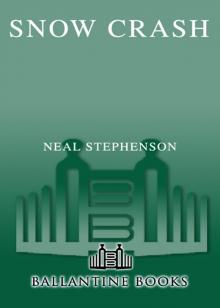 Snow Crash
Snow Crash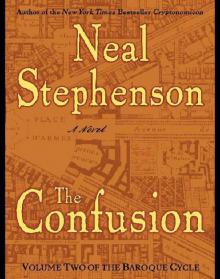 The Confusion: Volume Two of the Baroque Cycle
The Confusion: Volume Two of the Baroque Cycle The Rise and Fall of D.O.D.O.
The Rise and Fall of D.O.D.O. The Diamond Age: Or, a Young Lady's Illustrated Primer
The Diamond Age: Or, a Young Lady's Illustrated Primer The Big U
The Big U The System of the World: Volume Three of the Baroque Cycle
The System of the World: Volume Three of the Baroque Cycle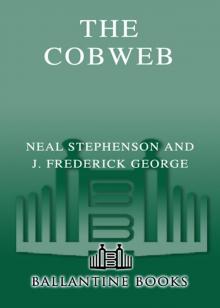 The Cobweb
The Cobweb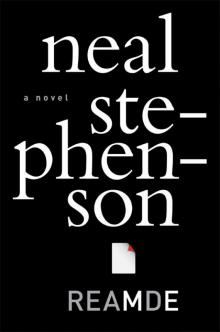 Reamde
Reamde Fall; or, Dodge in Hell
Fall; or, Dodge in Hell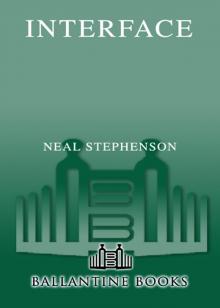 Interface
Interface Quicksilver
Quicksilver The Mongoliad: Book Three
The Mongoliad: Book Three Seveneves
Seveneves Atmosphæra Incognita
Atmosphæra Incognita In the Beginning...Was the Command Line
In the Beginning...Was the Command Line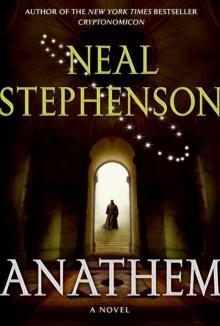 Anathem
Anathem The Rise and Fall of D.O.D.O.: A Novel
The Rise and Fall of D.O.D.O.: A Novel The Mongoliad: Book Two
The Mongoliad: Book Two Diamond Age or a Young Lady's Illustrated Primer
Diamond Age or a Young Lady's Illustrated Primer THE System OF THE WORLD
THE System OF THE WORLD The Mongoliad: Book One tfs-1
The Mongoliad: Book One tfs-1 Some Remarks: Essays and Other Writing
Some Remarks: Essays and Other Writing Zodiac
Zodiac Spew
Spew The Baroque Cycle: Quicksilver, the Confusion, and the System of the World
The Baroque Cycle: Quicksilver, the Confusion, and the System of the World The Diamond Age
The Diamond Age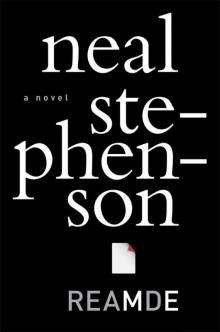 Reamde: A Novel
Reamde: A Novel In the Kingdom of Mao Bell
In the Kingdom of Mao Bell Mother Earth Mother Board
Mother Earth Mother Board Twelve Tomorrows - Visionary stories of the near future inspired by today's technologies
Twelve Tomorrows - Visionary stories of the near future inspired by today's technologies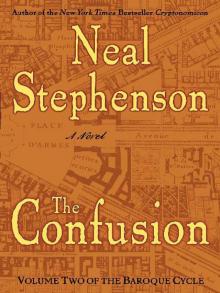 The Confusion
The Confusion The Great Simoleon Caper
The Great Simoleon Caper The Mongoliad: Book Three tfs-3
The Mongoliad: Book Three tfs-3